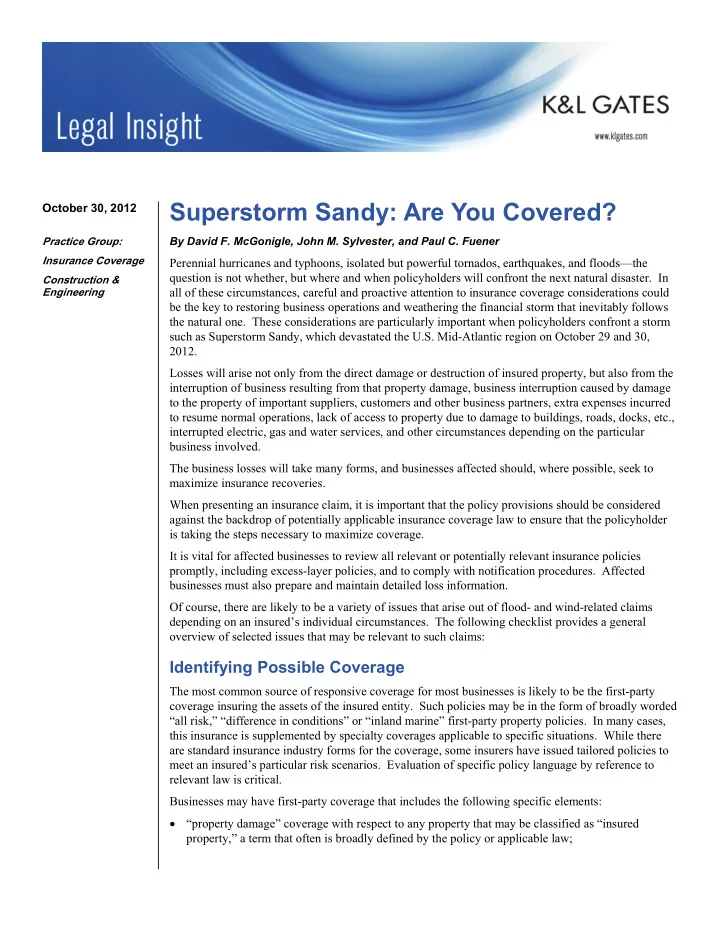

Superstorm Sandy: Are You Covered? October 30, 2012 By David F. McGonigle, John M. Sylvester, and Paul C. Fuener Practice Group: Insurance Coverage Perennial hurricanes and typhoons, isolated but powerful tornados, earthquakes, and floods—the question is not whether, but where and when policyholders will confront the next natural disaster. In Construction & all of these circumstances, careful and proactive attention to insurance coverage considerations could Engineering be the key to restoring business operations and weathering the financial storm that inevitably follows the natural one. These considerations are particularly important when policyholders confront a storm such as Superstorm Sandy, which devastated the U.S. Mid-Atlantic region on October 29 and 30, 2012. Losses will arise not only from the direct damage or destruction of insured property, but also from the interruption of business resulting from that property damage, business interruption caused by damage to the property of important suppliers, customers and other business partners, extra expenses incurred to resume normal operations, lack of access to property due to damage to buildings, roads, docks, etc., interrupted electric, gas and water services, and other circumstances depending on the particular business involved. The business losses will take many forms, and businesses affected should, where possible, seek to maximize insurance recoveries. When presenting an insurance claim, it is important that the policy provisions should be considered against the backdrop of potentially applicable insurance coverage law to ensure that the policyholder is taking the steps necessary to maximize coverage. It is vital for affected businesses to review all relevant or potentially relevant insurance policies promptly, including excess-layer policies, and to comply with notification procedures. Affected businesses must also prepare and maintain detailed loss information. Of course, there are likely to be a variety of issues that arise out of flood- and wind-related claims depending on an insured’s individual circumstances. The following checklist provides a general overview of selected issues that may be relevant to such claims: Identifying Possible Coverage The most common source of responsive coverage for most businesses is likely to be the first-party coverage insuring the assets of the insured entity. Such policies may be in the form of broadly worded “all risk,” “difference in conditions” or “inland marine” first-party property policies. In many cases, this insurance is supplemented by specialty coverages applicable to specific situations. While there are standard insurance industry forms for the coverage, some insurers have issued tailored policies to meet an insured’s particular risk scenarios. Evaluation of specific policy language by reference to relevant law is critical. Businesses may have first-party coverage that includes the following specific elements: “property damage” coverage with respect to any property that may be classified as “insured property,” a term that often is broadly defined by the policy or applicable law;
Superstorm Sandy: Are You Covered? “business interruption” coverage, which generally covers the insured’s loss of earnings or revenue resulting from property damage caused by an insured peril, but often leads to significant disputes regarding the proper quantification of the insured loss; “contingent business interruption” coverage, which generally covers the insured with respect to losses, including lost earnings or revenue as a result of damage to property of a supplier, customer or some other business partner or entity; “extra expense” coverage, which generally covers the insured for certain extra expenses incurred by the insured as a result of an insured event and in order to resume normal operations and mitigate other losses; “ingress and egress” coverage, which generally covers the insured when access to a business premises or location is blocked for a time; “civil authority” coverage, which generally covers the insured for losses arising from an order of a governmental authority that interferes with normal business operations; “service interruption” coverage, which generally covers the insured for losses related to electric or other power supply interruption; “defense” coverage, which may cover the insured for defense costs incurred with respect to claims alleging that the insured is responsible for damage to covered property of others; and “claim preparation” coverage, which generally covers the insured for the costs associated with compiling and certifying a claim. Presenting a Claim Most policies identify specific procedures to be followed in presenting a claim, and some of these procedures may have timing deadlines associated with them. Failure to comply with these procedures and time limits may give insurers a basis to attempt to deny a claim otherwise covered under the policy. In addition to notification and claim submission procedures, consideration also should be given to the manner in which a claim is presented (for example, as a flood, service interruption or civil authority claim). This can sometimes have an impact on the ultimate recovery, particularly in the context of limits of liability and deductibles, which may be expressed to be “per occurrence” or “per loss.” The presentation of the claim could affect the number of deductibles applied or the amount of the limits available. Where policies have specific exclusions applicable to certain perils or circumstances, it is important the insured also take these into account when presenting its claim. In all cases, an insured should promptly collect and document its loss information, evaluate the information in light of the policy wording and applicable law, and present it to the appropriate insurers in a timely and coverage-promoting manner. Advance Payments Businesses often need insurance to resume normal business operations and thus cannot afford a protracted adjustment period. Indeed, an insurer’s delay in making appropriate and periodic payments may cause an increase in the covered timeframe for business interruption and extra expense purposes. 2
Recommend
More recommend